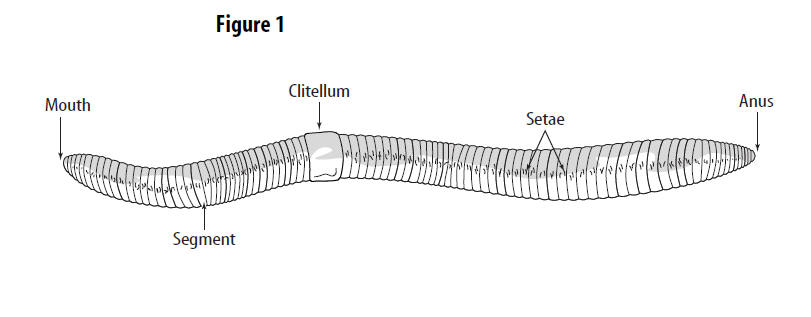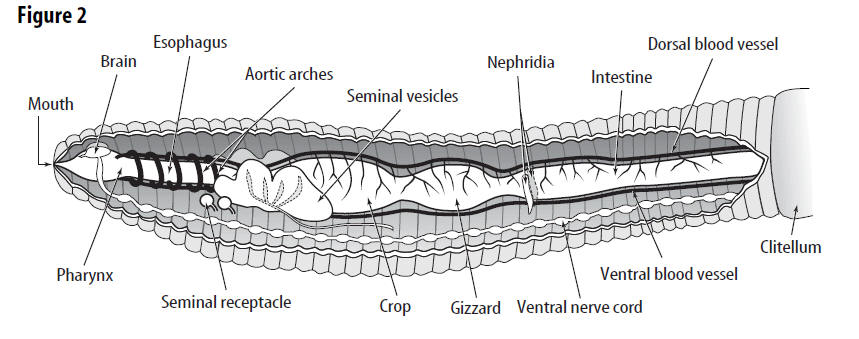Part A—External Structure
1.
Place a preserved earthworm lengthwise in the dissecting pan with the darker side up. This is the dorsal or top side. CAUTION:Wash hands thoroughly after handling worm.
2.
Examine the external structure and identify the parts shown in Figure 1.3.
Run your fingers lightly across the top, bottom, and both sides of the earthworm. The bristles that you feel are called setae. Examine the setae with a hand lens. Estimate the number of setae on each segment.4.
Locate the mouth. The part that hangs over the mouth is called the prostonium.5.
Find the thickened band circling the body. This is the clitellum. It forms a cocoon for depositing the eggs during reproduction.6.
Locate the anus (see Figure 1).
Part B—Internal Structure
Directions:
Read the instructions carefully and study Figures 1 and 2 before you begin to disect. Identify structures to be disected before you begin.CAUTION:
Always be careful with all sharpobjects.
1.
With the dorsal side up, pin both ends of the worm to the wax in the dissecting pan.2.
With scissors, begin about 2 cm in front ofthe clitellum and cut forward through the body wall just to the left of the dorsal blood vessel. Use care to cut through only the body wall.
See Figure 3.
3.
Separate the edges of the cut. Observe the space between the body wall and the intestine. This is the body cavity or coelom.4.
Observe the partitions between the segments. Use a dissecting needle to break these partitions. Then pin down the sides of the body wall.5.
Observe the tubelike digestive system. Identify the pharynx in segments 4 and 5. It is used to swallow food.6.
Follow the esophagus to segment 15.7.
Locate the large thin-walled crop. Food is stored in the crop until it is digested.8.
Locate the gizzard just behind the crop. Food is broken down by a grinding action in the gizzard here. The intestine extends from the gizzard to the anus. Digestion of food occurs in the intestine.9.
Each earthworm has both male and female reproductive organs. Alongside the esophagus in segments 9 and 10 are two pairs of seminal receptacles. The seminal receptacles receive sperm from another worm. In front of the receptacles in segments 10, 11, and 12 are seminal vesicles where sperm is stored.10.
Use a hand lens to find the small ovaries where eggs are produced. The ovaries are located under the seminal vesicles.11.
Locate the dorsal blood vessel. It carries blood to the heart-like structure, called the aortic arches. Carefully remove the white seminal vesicles from the left side of thebody. Find the aortic arches, which branch from the dorsal blood vessel and passaround the esophagus. These arches join the ventral blood vessel below the esophagus. These aortic arches contract and function as hearts. The ventral blood vessel carries blood toward the skin and intestine.12.
Use a hand lens to observe the small white tubes along each side of the digestive tract. These tubes are excretory organs called nephridia. They are found in all segments except the first three and the last. They remove the wastes from the body.13.
Find the double nerve ganglion, or brain, of the earthworm near segment 2. The brain connects with the ventral nerve cord, which extends the length of the body. The nerve cord is a white line on theventral body wall.14. CAUTION:
Give all dissected materials to your teacher for disposal. Always wash your hands after a dissection procedure.
Questions and Conclusions
1.
How many setae were located on each segment?2.
What is the function of the setae?3.
Describe the function of the following organs:| a. pharynx | |
|
b. crop |
|
|
c. gizzard |
|
| d. aortic arches | |
| e. dorsal blood vessel | |
| f. ventral blood vessel | |
| g. clitellum | |
| h. nephridia | |
| i. seminal vesicles | |
| j. intestine | |
|
k. ganglia |
Hands-On
Data and Observations
List the organs found in each system in Table 1.
Table 1
| 1. Digestive | |
| 2. Reproductive | |
| 3. Circulatory | |
| 4. Excretory | |
| 5. Nervous |
System Organs
Systems and Organs of an Earthworm
4.
Why is it said that the earthworm has a “closed” circulatory system?
Can you identify the external parts of the earthworm?
Can you identify the internal organs and organ systems of an earthworm?